Christ Church Uniting Church
King William Road, Waywille
B 1983 Roger H. Pogson; 2-2/3 and 1-1/3 added 2001 Tom
Way.
2m, 9spst, 3c, tr. Gt: 8.4.2-2/3.2.III. Sw: 8.4.2.1-1/3.II. Ped: 16.
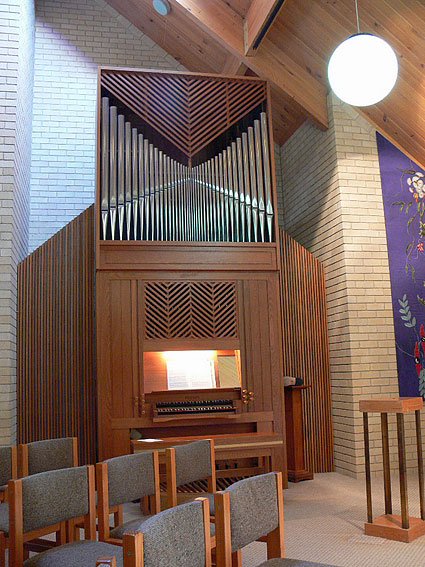
From the 2009 OHTA Conference Book, David Shield writes:
The
congregation worshipping at Wayville Christ Church Uniting traces its history
to the first half of the 19th century.
Worshipping first in Arthur Street, Unley, the facilities were outgrown
and a saw a larger church built in King William Road. Changing circumstances led to a downsizing, selling the old
and constructing the new. Initially,
a barrel organ accompanied the singing, but was replaced with a succession of
reed instruments. The Broad
family, when at the King William Street site, pushed for a pipe organ and two
were eventually installed. When
the congregation moved to the present site a new organ was acquired from Roger
Pogson, of Orange, New South Wales.1
The
history of the congregation at Christ Church may be traced back to 1849. A Wesleyan Methodist chapel in Arthur
Street, Unley, was opened on Sunday 7 December 1851 but soon became
inadequate. This building
possessed a barrel organ which was replaced by a reed organ from James Broad.2
In
1877, an acre of land was purchased on King William Road. On 24 May 1880 the foundation stone of
Unley Wesleyan Methodist Church was laid, opening January 1881.
This
became the spiritual home for James Broad and his family. Broad was a successful business man
and, from a young age, Wesleyan lay preacher connected with Pirie Street. His eldest son was taken into
partnership sharing his father’s love for music and having pretensions of being
an organ builder.3
Prominent in the church, neither father nor son could convince the
church authorities to purchase a pipe organ for the new building. The trustees had financial priorities
in other directions. Various
memorials to the Broads can still be seen in the new church. Things did improve, however, and a pipe
organ eventuated.
Further
research is needed to determine the builder of the organ finally placed in the
church in 1902. This instrument
served until 1926 when it was sold to make way for a new one. It went to Holy Trinity on North
Terrace and became the nucleus of the Grenfell Memorial organ in that church. The new instrument was provided by
William Leopold Roberts and remained in the building till sold to private
possession in 1982.
In
1976, changing circumstances had led to a rationalisation of properties and the
King William Road church and Roberts organ was sold. The congregation moved to the Parkin-Wesley Theological
College campus worshipping in Lade Hall until Christ Church was completed and
dedicated on 17 April 1983. The
architect for the new building was Colin Norton, of Brown Falconer Pty Ltd. With the new church came a new organ
built by Roger Pogson in 1983. This was the first instrument to come from the
firm’s new manufactory in Orange, New South Wales. The casework has pipe shades with diagonal motifs deriving
from the angular roof structure and has been constructed from Brazilian
myrtle. The keyboards are capped
in Tasmanian myrtle.
The
Spitzgedeckt 2-2/3 and Nineteenth have been added later on original spare
slides.
Roger H. Pogson Pty Ltd 1983
2 manuals, 11 speaking stops, mechanical action
|
GREAT ORGAN |
|
|
|
Rohrflute |
8 |
|
|
Principal |
4 |
in façade |
|
Spitzgedeckt |
2-2/3 |
added later |
|
Spitzflute |
2 |
|
|
Mixture |
III |
|
|
Swell to Great |
|
|
|
|
|
|
|
SWELL ORGAN |
|
|
|
Gemshorn |
8 |
|
|
Flute |
4 |
|
|
Principal |
2 |
|
|
Nineteenth |
1-1/3 |
added later |
|
Sesquialtera |
II |
|
|
Tremulant |
|
|
|
|
|
|
|
PEDAL ORGAN |
|
|
|
Bourdon |
16 |
wood |
|
Great to Pedal |
|
|
|
Swell to Pedal |
|
|
Compass: 56/30
Balanced swell pedal
Couplers operated by toe
pedals
Attached drawstop console
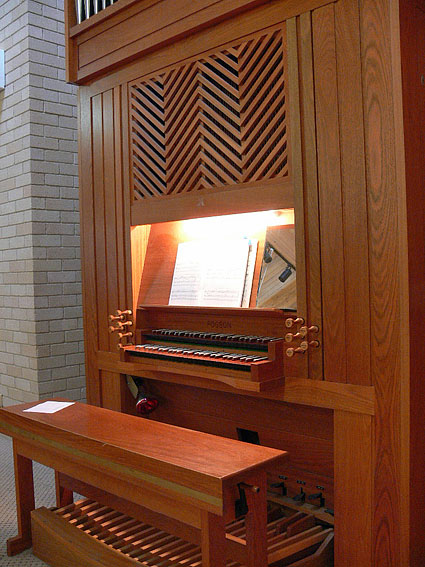
Photos: JRM (Oct 2009)
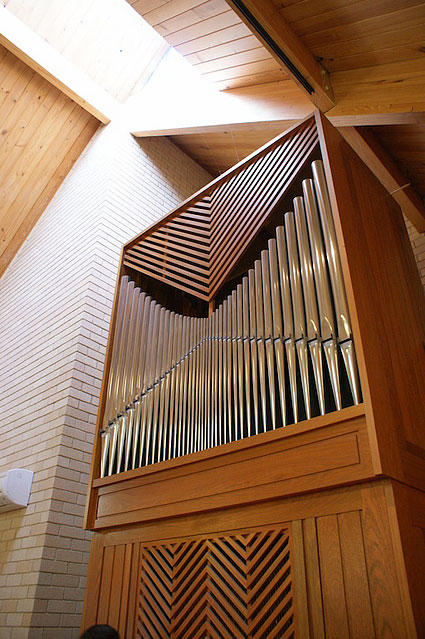
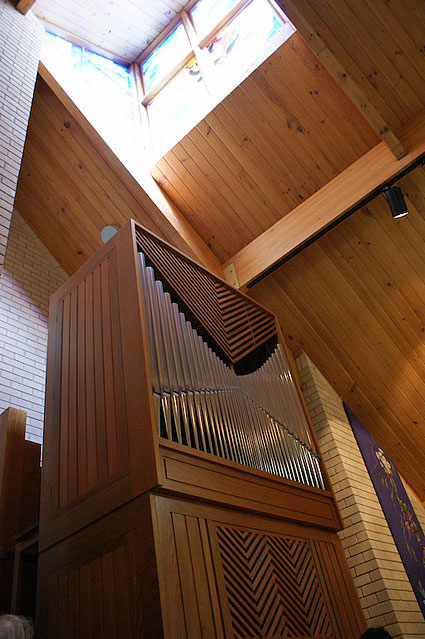
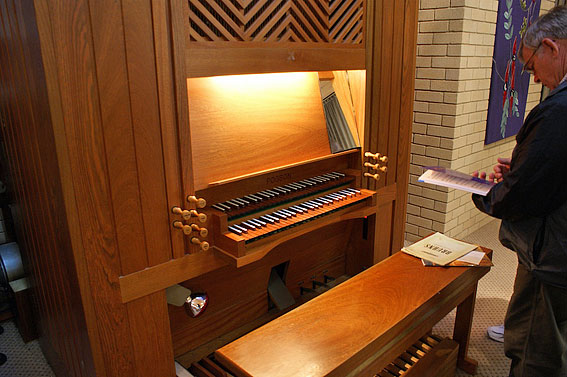
3 Photos above: Rodney Ford (Oct 2009)
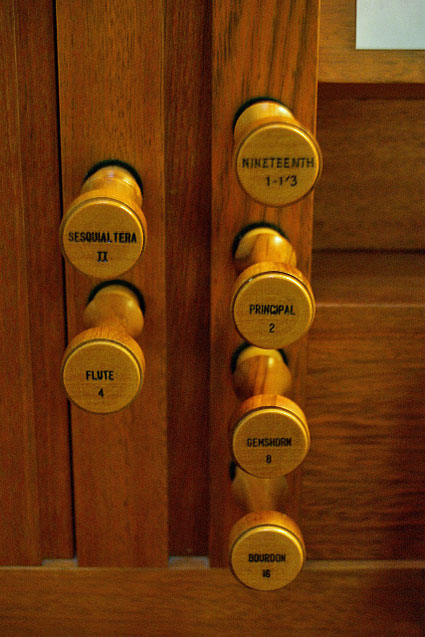
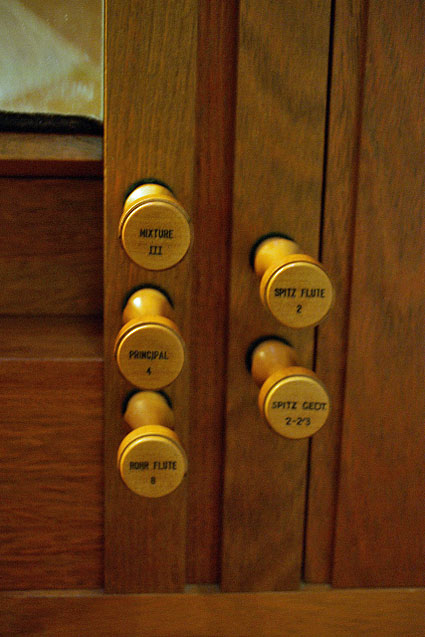
Photos: PdL (Oct 2009)
_________________________________________________________________________
1 Information from
detailed research D. Shield and church pamphlet: UCA Christ Church A
Christian Community of Care Worship Study fellowship [1983]
2 Register, 15 October 1878, p. 5.1; James Broad became sole
agent for the sale of Bell American organs
3 For the work of J.J. Broad see also
sections on Kapunda and connections to Rendall and Mackenzie. His brother Edwin became a telegraphist
and was a competent organist.
Alfred, the artist, may have decorated the pipework of the organ at
Christ Church Kapunda, the Moonta Mines Uniting (formerly Methodist) Church and
the Moonta Anglican Church.